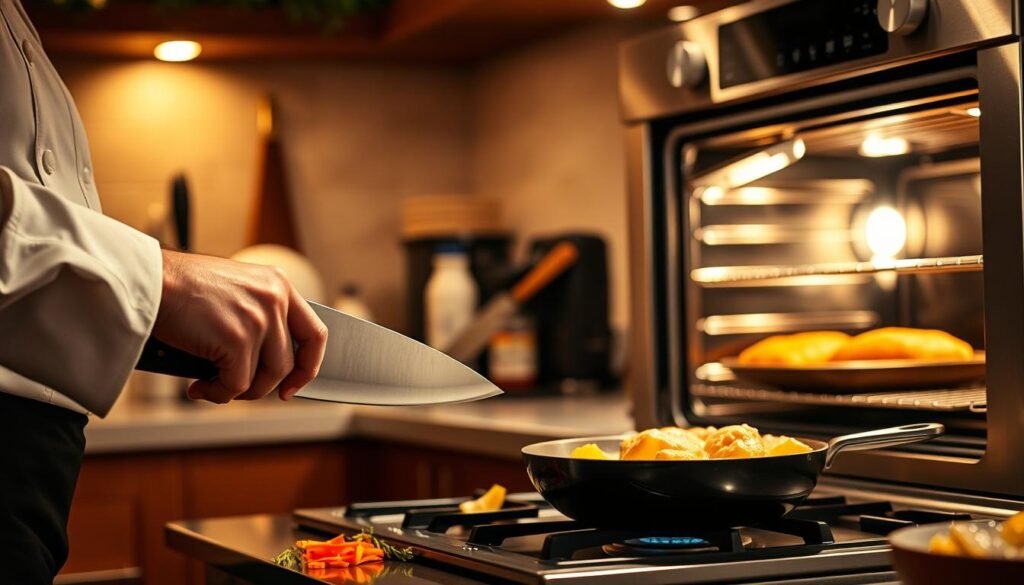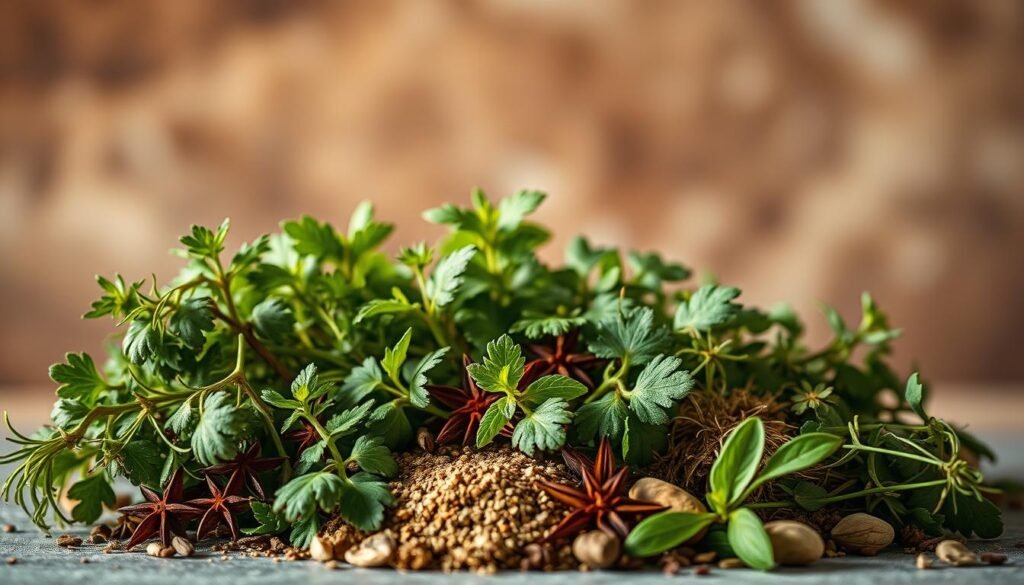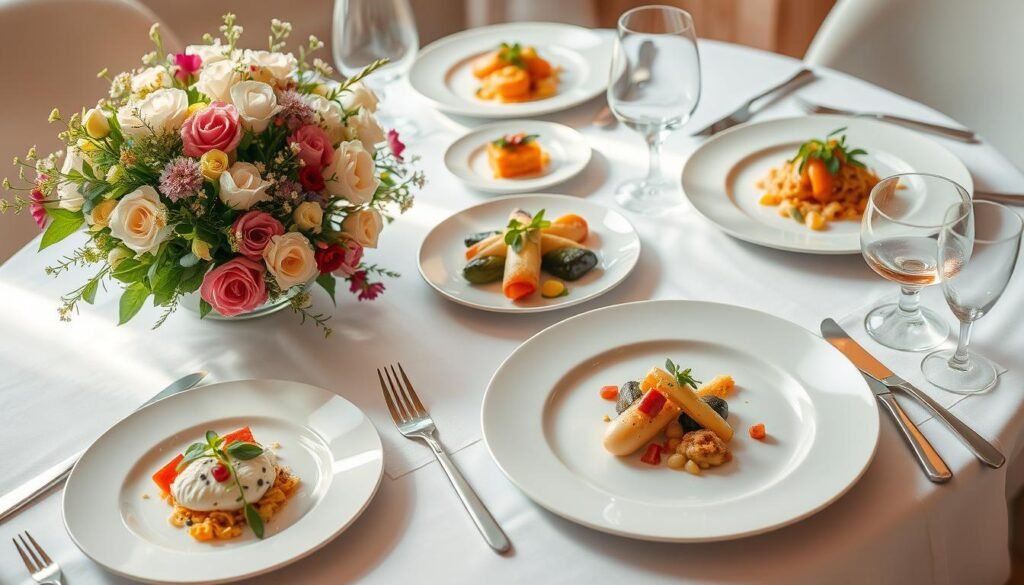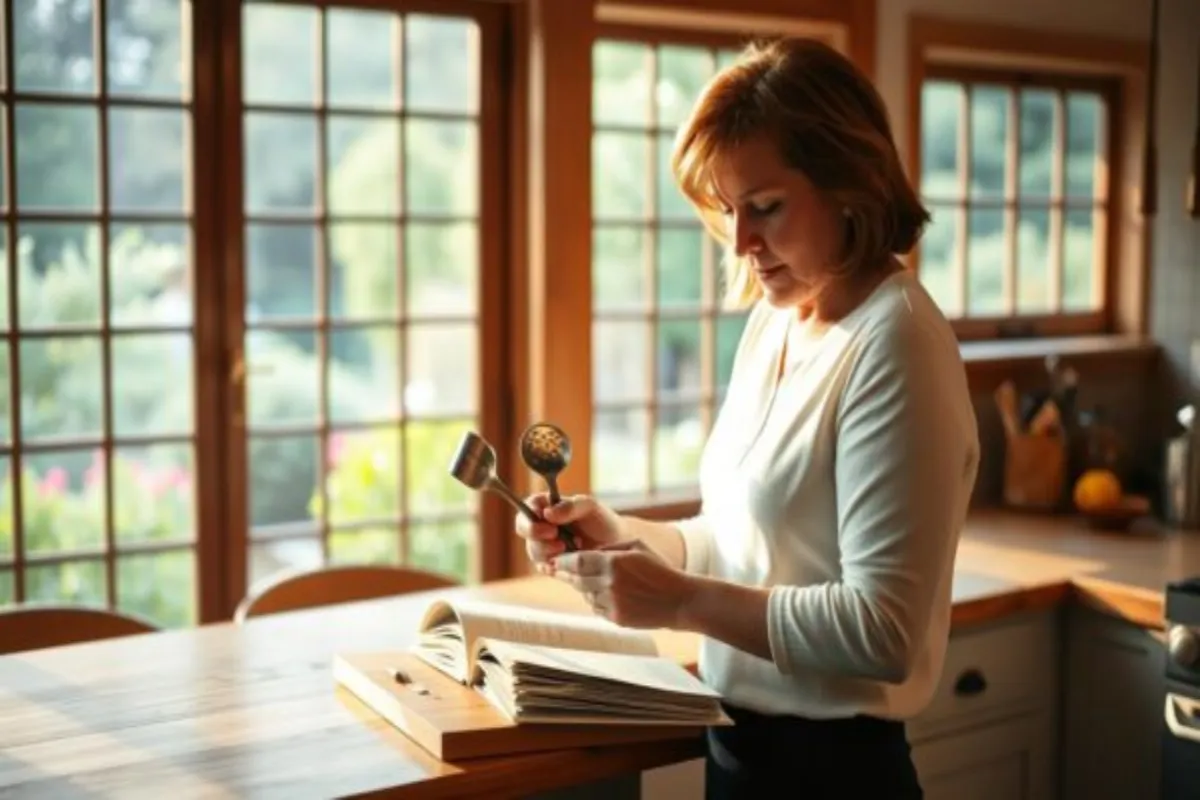Ina Garten, known as the Barefoot Contessa, is loved for her simple yet elegant cooking style. She believes in using the best ingredients and techniques to make gourmet dishes. Her tips are perfect for both beginners and experienced cooks.
In this article, you’ll learn Ina Garten cooking tips. You’ll discover how to balance flavors and create a cozy kitchen. Her advice will help you improve your cooking skills and make delicious dishes.
Key Takeaways
- Utilize quality ingredients for better flavor.
- Master fundamental cooking techniques for success.
- Allocate prep time to enhance your cooking experience.
- Prioritize flavor balance in your dishes.
- Experiment and have fun to develop your own cooking style.
Embrace Quality Ingredients
Using top-notch ingredients makes cooking more fun and brings out the best in your dishes. Ina Garten stresses the need for the finest ingredients. This ensures your meals are tasty and good for you. Adding seasonal produce, fresh herbs, and premium olive oil will make your dishes unforgettable.
Choose Seasonal Produce
Seasonal produce is not only tastier but also helps local farmers and the planet. Choosing fruits and veggies in season means you get the best taste and freshness. For instance, summer berries are perfect for salads, and autumn squash makes great soups. Find the freshest ingredients at local markets or farms.
Invest in Fresh Herbs
Fresh herbs are key in Ina Garten’s recipes, adding a burst of flavor. They can turn simple meals into gourmet dishes. Grow your own herbs or buy them from local sellers for the best taste. Basil, rosemary, and cilantro are great choices that complement many foods.
Use High-Quality Olive Oil
High-quality olive oil is essential in many of Ina Garten’s recipes. The right oil can make a big difference in your dishes’ taste. Choose a strong, flavorful oil for better cooking results. Opt for extra virgin olive oil for the best taste and health benefits.
Master Basic Techniques
Learning essential cooking techniques is key for any chef. These skills make your dishes better and your cooking more enjoyable. Ina Garten focuses on sautéing, roasting, and knife skills to boost your cooking.
The Art of Sautéing
Sautéing cooks ingredients fast, keeping their taste and texture. Start by heating your pan and adding oil. This method gives a great sear and caramelizes veggies, making them sweet.
When done right, sautéed veggies are colorful and full of flavor. They’re a main part of many dishes.
Essential Knife Skills
Knife skills are vital for kitchen efficiency and safety. Using a knife well means you can chop, dice, and mince fast. This saves time and makes your dishes look better.
Improving your knife skills means quicker meals and more creativity in the kitchen.

Don’t Rush the Process
Spending time in the kitchen can make your meals better. It’s important to focus on prep time. This makes cooking smoother and more fun. Preparing ingredients ahead lets you pay attention to the details, leading to better dishes.
Importance of Prep Time
Prep time is key to cooking well. Before cooking, gather and chop your ingredients. This reduces stress and helps you follow recipes better. Easy cooking tips say being organized leads to better results.
Understanding Cooking Times
Knowing cooking times is essential. Whether baking, grilling, or simmering, knowing the time helps manage your meal. Mastering this skill prevents overcooked veggies or undercooked proteins. It’s a crucial easy cooking tip.
Enjoying the Cooking Journey
Cooking should be enjoyable, not rushed. Take time to enjoy each step. Savor the smells, textures, and flavors. A relaxed approach makes cooking a chance for creativity and discovery.
Make Flavor a Priority
In the world of cooking, flavor is key. Learning to balance flavors is crucial for great dishes. It’s about finding the right mix of sweet and savory, and adding a zing from citrus.
Balancing Sweet and Savory
Flavor starts with sweet and savory working together. When they’re just right, your food becomes complex and tasty. Try different mixes to find new flavors that make your meals stand out.
Using Citrus for Brightness
Citrus, like lemon or orange zest, adds a burst of freshness. Its acidity cuts through richness, making flavors pop. A squeeze of citrus can turn a simple dish into something special.
Incorporating Umami Flavors
Umami adds a deep, satisfying layer to your cooking. Mushrooms, soy sauce, and Parmesan are great sources. They make your food more exciting and encourage you to try new things.

Utilize the Power of Herbs and Spices
Herbs and spices add depth and complexity to your dishes. Learning to use herbs well means knowing the difference between dry and fresh. Choosing the right one can make your food stand out.
Flavor layering is key to making meals memorable. It turns simple ingredients into something amazing.
Dry Vs. Fresh Herbs
Fresh herbs are known for their bright flavors and smells. They’re best added just before cooking ends to keep their freshness. Herbs like basil, cilantro, and parsley are essential in many recipes.
Dry herbs, on the other hand, pack a punch and last longer. Thyme, oregano, and rosemary are great for slow-cooked meals. They blend their flavors beautifully over time.
Layering Flavors with Spices
Using spices well means mastering flavor layering. Begin with basics like cumin and coriander to create a solid base. Then, add bold spices like smoked paprika or cumin to deepen the flavor.
Mixing different spices can create a rich tapestry of tastes. This can turn a simple dish into something unforgettable. Don’t be afraid to try new spice combinations to surprise yourself and enhance your cooking.
Plan Your Meals Ahead
Planning your meals can make cooking less stressful and more efficient. By choosing simple weeknight dinners, you can save time and enjoy your meals more. This way, you can also shop smarter, making sure you have everything you need.
Weeknight Dinner Ideas
Look for quick and easy recipes for busy nights. Here are some ideas:
- Grilled chicken served with steamed vegetables.
- Pasta tossed with olive oil and fresh herbs.
- Stir-fried tofu with colorful bell peppers and snap peas.
- A hearty quinoa salad topped with lemon vinaigrette.
- Pan-seared salmon paired with roasted asparagus.
Making Lists for Grocery Shopping
Creating a grocery list is key to good meal planning. A good list saves time and helps avoid buying things you don’t need. Organize your list by store section, like produce and meats, to make shopping easier. This way, you’ll have everything you need for your meals, making cooking a breeze.
Adapt Recipes to Your Taste
Cooking lets you be creative by adapting recipes. Making confident substitutions can turn your favorite dishes into something new. This makes cooking more fun and lets you add your personal touch.
Substitutions with Confidence
Think about what ingredients you have when you’re cooking. Swapping one ingredient for another can change a dish’s flavor and texture. For instance, using shrimp instead of chicken can make a big difference.
Adapting recipes this way can lead to exciting new dishes. It opens up a world of possibilities in the kitchen.
Personalizing Classic Dishes
Classic recipes can get a fresh twist with your own touch. Personalizing recipes makes them fit your taste and dietary needs. You might choose different grains in a risotto or change the herbs in a sauce.
These changes keep classic dishes interesting and add your own creativity. Each adaptation shows off your cooking style while honoring tradition.
Don’t Forget the Presentation
How a dish looks can change how we see it. Making your meals look good can turn a simple dish into something special. Using creative ways to plate your food makes it look better and makes eating more fun. You might get lots of compliments and happy guests because of your effort.
Plating Like a Pro
Learning to plate well takes focus and creativity. Start with the right plate; a big, white one is great for showing off food colors. Try to balance your food and make a centerpiece. Adding layers and heights makes your dish more interesting to look at.
Garnishes That Wow
Adding garnishes makes your food stand out. Fresh herbs like basil or cilantro add color and taste. A drizzle of good olive oil or balsamic can highlight your dish’s flavors. Even small things like microgreens or edible flowers can make your meal look amazing.

Create a Cozy Cooking Environment
A cozy kitchen sparks creativity and joy. Good kitchen organization is key to making it functional and welcoming. A quick kitchen makeover can turn it into a fun place for cooking.
Set Up Your Kitchen Space
Organize your kitchen to make cooking easier. Here are some tips for a better kitchen:
- Make zones for prep, cooking, and cleaning.
- Use drawer dividers for utensils.
- Keep often-used items within reach.
- Add shelves or cabinets that match your style.
The Importance of Good Lighting
Good lighting makes cooking better. It helps you see clearly and work more efficiently. Here’s how to light up your kitchen:
- Put task lights over the stove and cutting boards.
- Keep windows clear for natural light.
- Choose warm-toned lights for a cozy feel.
- Use dimmers to change the light as needed.
Learn to Cook with Your Instincts
Building your cooking instincts can make cooking much more enjoyable. It’s important to develop your palate so you can tell apart different flavors. When you trust your taste buds, you can try new things in the kitchen.
Develop Your Palate
Getting better at tasting takes time and practice. Try out different ingredients and notice their unique tastes. As you try new recipes, think about which flavors you like best.
Trusting Your Tastes
Trusting your taste means being confident in your cooking choices. Let your instincts guide you as you mix different ingredients. This way, you connect more with your food and enjoy cooking even more.
Have Fun and Experiment in the Kitchen
Exploring the kitchen can be a thrilling adventure. Trying new recipes lets you discover new flavors and techniques. Each dish is a chance to find what you love and keeps cooking exciting.
Trying New Recipes
Trying new dishes pushes your skills and sparks creativity. Exploring different cuisines can lead to amazing surprises. Whether it’s a spicy Thai curry or a French souffle, it makes cooking more fun and rewarding.
Embracing Culinary Mistakes
Mistakes in the kitchen are a big part of learning. Each error teaches you something new. Instead of seeing them as failures, view them as steps to mastering new skills.
Many famous recipes started as happy accidents. This shows that mistakes can lead to amazing dishes.
FAQ
What are Ina Garten’s top tips for choosing quality ingredients?
What basic cooking techniques should I master according to Ina Garten?
Why is taking time during cooking important?
How does Ina Garten recommend making flavors a priority?
How can I utilize herbs and spices effectively?
What are some meal planning tips from Ina Garten?
How can I personalize recipes to suit my taste?
What presentation tips does Ina Garten offer?
How can I create a cozy environment in my kitchen?
How can I trust my instincts while cooking?
Why is it important to have fun and experiment in the kitchen?
How Much is 1 Cup of Green Beans?check this out for more

